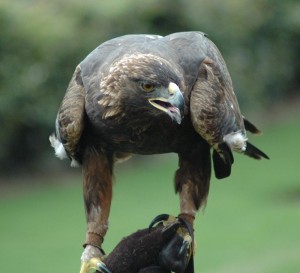New Tool Predicts Bird Deaths from Wind Turbines

Wikimedia Commons
Research looked at Golden Eagle deaths caused by wind turbines.
Texas leads the nation in wind power, but some environmentalists worry about bird deaths cause by wind turbines – typically, birds fly into the blades of the turbines.
Now, a new approach pioneered by the U.S. Geological Survey and the U.S. Fish and Wildlife Service hopes to decrease those fatalities by trying to calculate the probability of bird-turbine collisions, while recognizing the inherent uncertainty of the phenomenon.
The approach is basically a mathematical formula. You plug in what you know about the local bird population, and where the turbines will be built. You run the numbers and get a fatality estimate. Dr. Leslie New is an assistant professor of statistics in Washington State University. She helped create the model looking at Golden Eagles, an endangered species; though, she says the model could be used for other species like the Bald Eagle.
Obviously, killing an endangered eagle is illegal, but wind farms can apply for a permit to exempt them from prosecution under the Endangered Species Act. New says the permits provide more an on-the-ground assessment of deaths as a result of collisions, but they will also help the model in predicting patterns of eagle deaths.
“[W]hen you’re dealing with a permit, it’s much easier to be open because there [are] no legal concerns regarding what to do about the fact that the eagle has collided,” she says.
New says reported death could help change the placement of turbines or the times they run to mitigate bird deaths, but could also ultimately reduce the uncertainty of the model’s variables.The USGS says it’s aware of at least one Golden Eagle death caused by a turbine in the Texas Panhandle.
Brian Millsap of the U.S. Fish and Wildlife Service says raptors, and Golden Eagles especially, are prone to colliding with the blades of wind turbines, something that carries legal ramifications, as well as ecological ones.
“Any eagle deaths are a concern legally, because they’re protected under the Bald and Golden Eagle Protection Act,” Millsap says. “But also biologically, because Golden Eagle populations are, by our estimates, stable and anything that’s causing increased mortality is potentially going to cause populations to decline.”
Millsap says the majority of wind farm projects across the country aren’t permitted, but that the process of obtaining a permit is a relatively new one.
